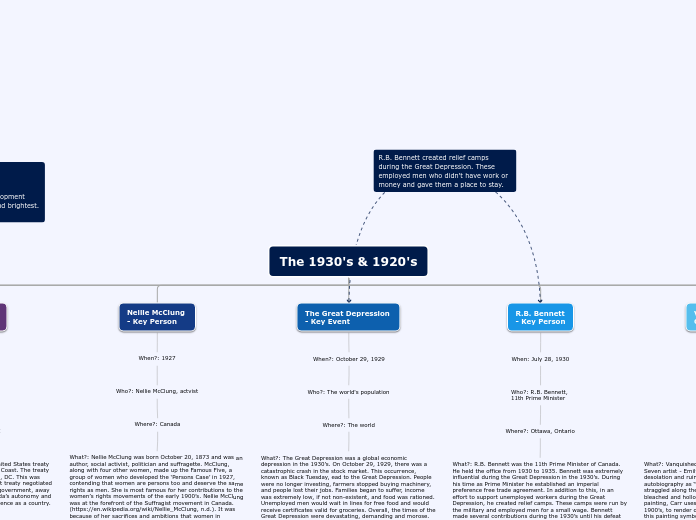door Claire Gallagher 4 jaren geleden
364
The 1920's & 1930's

door Claire Gallagher 4 jaren geleden
364

Meer zoals dit
Where?: Havana, Cuba, Germany, Canada
What?: Jewish people in Canada and all over the world, were at a large minority. William Lyon Mackenzie King believed in keeping his population pure - free of the Jewish people. In 1939, 900 Jewish refugees fled from Germany on the S.S. Louis with the intent of going to Havana, Cuba, away from Adolf Hitler’s power. However, once the ship arrived in Cuba, the Jewish people were prohibited from entering the country. The ship then tried to disembark the passengers in other countries, including Canada, but were denied access. The S.S. Louis was forced to returned its passengers to Europe where, sadly, more than 200 of them died during the Holocost.
The S.S. St. Louis 1939
Where?: Spain
What?: The Mac Paps or the Mackenzie-Papineau Battalion were a Canadian battalion who fought in the Spanish Civil War in the late 1930’s. Canada was the second largest percentage of soldiers fight in the civil war next to France. By summer of 1937, 1,200 Canadians were involved in the Spanish conflict. The battalion was lead by William Lyon Mackenzie King and Louis-Joseph Papineau. The battle then ended in April 1939, shortly before the start of WW1 in September.
The Mac Paps in Canada
Where?: Vancouver, BC
What?: Vanquished is a 1930 painting created by a Group of Seven artist - Emily Carr. The painting describes a scene of desolation and ruin. Carr explains her work in her autobiography as “a row of crazily tipped totem poles straggled along the low bank skirting Skedans Bay…. in their bleached and hollow upper ends stood coffin-boxes.” In this painting, Carr uses cubism, a popular art technique in the 1900’s, to render objects as the eye sees them. Some say that this painting symbolizes the times of the 1930’s, especially for Indegenous people.
Vanquished by Emily Carr, 1930
Where?: Ottawa, Ontario
What?: R.B. Bennett was the 11th Prime Minister of Canada. He held the office from 1930 to 1935. Bennett was extremely influential during the Great Depression in the 1930’s. During his time as Prime Minister he established an imperial preference free trade agreement. In addition to this, in an effort to support unemployed workers during the Great Depression, he created relief camps. These camps were run by the military and employed men for a small wage. Bennett made several contributions during the 1930’s until his defeat to William Lyon Mackenzie King during at 1935 election.
R.B. Bennett Born:July 3, 1870 Died:June 26, 1947
Where?: The world
What?: The Great Depression was a global economic depression in the 1930’s. On October 29, 1929, there was a catastrophic crash in the stock market. This occurrence, known as Black Tuesday, ead to the Great Depression. People were no longer investing, farmers stopped buying machinery, and people lost their jobs. Families began to suffer, income was extremely low, if not non-existent, and food was rationed. Unemployed men would wait in lines for free food and would receive certificates valid for groceries. Overall, the times of the Great Depression were devastating, demanding and morose.
Men in Newfoundland waiting for free food
Where?: Canada
What?: Nellie McClung was born October 20, 1873 and was an author, social activist, politician and suffragette. McClung, along with four other women, made up the Famous Five, a group of women who developed the ‘Persons Case’ in 1927, contending that women are persons too and deserve the same rights as men. She is most famous for her contributions to the women’s rights movements of the early 1900’s. Nellie McClung was at the forefront of the Suffragist movement in Canada. (https://en.wikipedia.org/wiki/Nellie_McClung, n.d.). It was because of her sacrifices and ambitions that women in Manitoba earned the right to vote and run for public office, making it the first province in the country to do so.
Nellie McClung Born: October 20, 1873 Died:September 1, 1951
Where?: Washington, DC
What?: The Halibut Treaty was a Canada-United States treaty to protect halibut supplies along the Pacififc Coast. The treaty was signed on March 3, 1923 in Washington, DC. This was significant to Canada because it was the first treaty negotiated and signed independently by the Canadian government, away from Britain. This was a major step in Canada’s autonomy and an event that marked our growing independence as a country.
Halibut fishing along the Pacific Coast
Where?: University of Toronto
What?: On January 11, 1922, insulin was first used in the treatment of diabetes. Injectable insulin was first discovered at the University of Toronto by Fredrick Banting, Charles Best, and James Colip as a way to treat people was diabetes. Before the 1920’s, diabetes was an untreatable disease; for thousands of years, people had been suffering and dying from diabetes. When the insulin is injected into the body, the pancreas reacts by producing more of it. This revolutionary discovery changed and saved the lives of many, and is even more significant today.
Jar of injectable insulin 1920's
Where?: Pittsberg, Pennsylvania, all around the world
What?: The Radio was used in the 1900’s as a source of communication, news, comedy and connection to the world. During the time of the war, it provided people with a sense of culture and entertainment. On November 2, 1920, radio station KDKA from Pittsburgh, PA made its to Canadian airways, becoming the nation's first commercial broadcast. Radios were also used widely during the 1920’s and 1930’s as a form of advertising during election periods. William Lyon Mackenzie King, the tenth prime minister of Canada, used radios to broadcast himself as Canada as electoral competition. The radio foreshadowed the technology to come in future years.
Early 1900's Crystal Radio Set